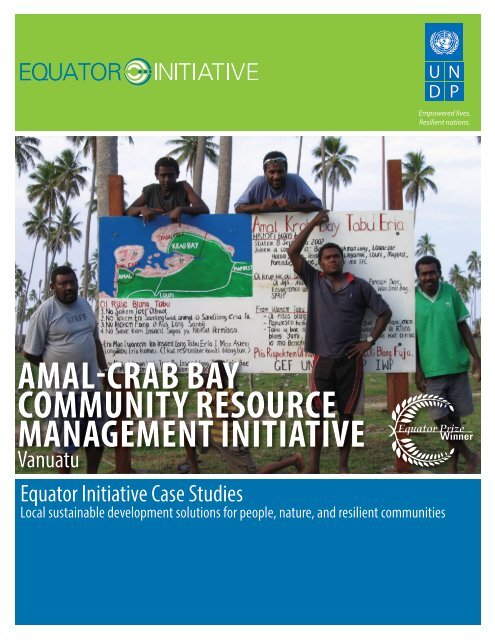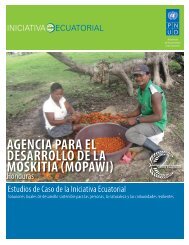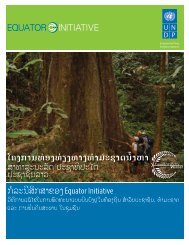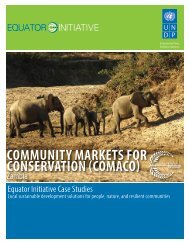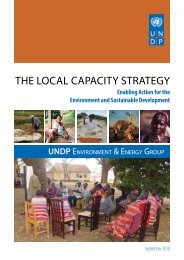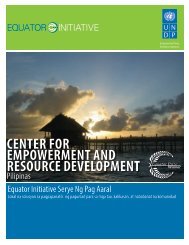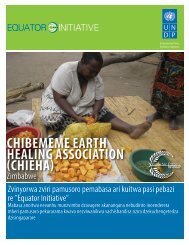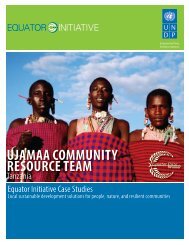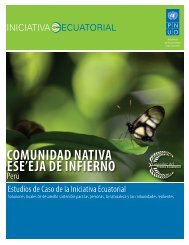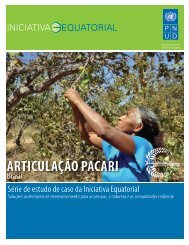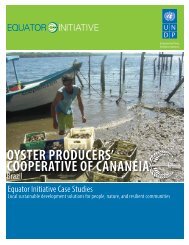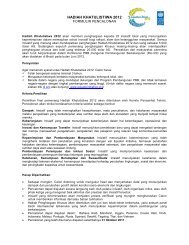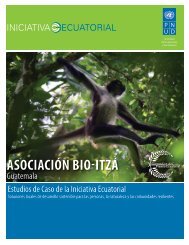AMAL-CRAB BAY Community Resource Management Initiative
AMAL-CRAB BAY Community Resource Management Initiative
AMAL-CRAB BAY Community Resource Management Initiative
Create successful ePaper yourself
Turn your PDF publications into a flip-book with our unique Google optimized e-Paper software.
Empowered lives.<br />
Resilient nations.<br />
<strong>AMAL</strong>-<strong>CRAB</strong> <strong>BAY</strong><br />
COMMUNITY RESOURCE<br />
MANAGEMENT INITIATIVE<br />
Vanuatu<br />
Equator <strong>Initiative</strong> Case Studies<br />
Local sustainable development solutions for people, nature, and resilient communities
UNDP EQUATOR INITIATIVE CASE STUDY SERIES<br />
Local and indigenous communities across the world are advancing innovative sustainable development solutions that work<br />
for people and for nature. Few publications or case studies tell the full story of how such initiatives evolve, the breadth of<br />
their impacts, or how they change over time. Fewer still have undertaken to tell these stories with community practitioners<br />
themselves guiding the narrative.<br />
To mark its 10-year anniversary, the Equator <strong>Initiative</strong> aims to fill this gap. The following case study is one in a growing series<br />
that details the work of Equator Prize winners – vetted and peer-reviewed best practices in community-based environmental<br />
conservation and sustainable livelihoods. These cases are intended to inspire the policy dialogue needed to take local success<br />
to scale, to improve the global knowledge base on local environment and development solutions, and to serve as models for<br />
replication. Case studies are best viewed and understood with reference to ‘The Power of Local Action: Lessons from 10 Years of<br />
the Equator Prize’, a compendium of lessons learned and policy guidance that draws from the case material.<br />
Click on the map to visit the Equator <strong>Initiative</strong>’s searchable case study database.<br />
Editors<br />
Editor-in-Chief:<br />
Managing Editor:<br />
Contributing Editors:<br />
Joseph Corcoran<br />
Oliver Hughes<br />
Dearbhla Keegan, Matthew Konsa, Erin Lewis, Whitney Wilding<br />
Contributing Writers<br />
Edayatu Abieodun Lamptey, Erin Atwell, Toni Blackman, Jonathan Clay, Joseph Corcoran, Larissa Currado, Sarah Gordon, Oliver Hughes,<br />
Wen-Juan Jiang, Sonal Kanabar, Dearbhla Keegan, Matthew Konsa, Rachael Lader, Patrick Lee, Erin Lewis, Jona Liebl, Mengning Ma,<br />
Mary McGraw, Gabriele Orlandi, Brandon Payne, Juliana Quaresma, Peter Schecter, Martin Sommerschuh, Whitney Wilding, Luna Wu<br />
Design<br />
Oliver Hughes, Dearbhla Keegan, Matthew Konsa, Amy Korngiebel, Kimberly Koserowski, Erin Lewis, John Mulqueen, Lorena de la Parra,<br />
Brandon Payne, Mariajosé Satizábal G.<br />
Acknowledgements<br />
The Equator <strong>Initiative</strong> acknowledges with gratitude the Amal-Crab Bay <strong>Community</strong> <strong>Resource</strong> <strong>Management</strong> <strong>Initiative</strong>, and in particular the<br />
guidance and inputs of Kevin Mores. All photo credits courtesy of the Amal-Crab Bay <strong>Community</strong> <strong>Resource</strong> <strong>Management</strong> <strong>Initiative</strong>. Maps<br />
courtesy of CIA World Factbook and Wikipedia.<br />
Suggested Citation<br />
United Nations Development Programme. 2012. Amal - Crab Bay <strong>Community</strong> <strong>Resource</strong> <strong>Management</strong> <strong>Initiative</strong>, Vanuatu. Equator <strong>Initiative</strong><br />
Case Study Series. New York, NY.
<strong>AMAL</strong>-<strong>CRAB</strong> <strong>BAY</strong> COMMUNITY<br />
RESOURCE MANAGEMENT INITIATIVE<br />
Vanuatu<br />
PROJECT SUMMARY<br />
The successes of the Amal-Crab Bay initiative in conserving<br />
marine resources in their tabu area, located on the<br />
eastern coastline of the island of Malekula, Vanuatu, has<br />
been underpinned by the use of a traditional resource<br />
management system and innovative awareness-raising<br />
efforts. The bay forms part of the Port Stanley mangrove<br />
area, and is home to extensive fringing reefs, sea grass beds,<br />
and a high abundance of crabs. This resource is critical for<br />
local livelihoods and food security, and has been the focus<br />
of sustainable harvesting regulations since 2002, when<br />
community chiefs instituted a ban on harvesting within the<br />
mangrove forests.<br />
These community-led efforts have been strengthened<br />
with support from an array of international partners; as a<br />
result, the initiative has overseen an increase in marine and<br />
coastal resources, compiled an evidence base for the bay’s<br />
mangrove ecosystem, and developed local ecotourism<br />
infrastructure.<br />
KEY FACTS<br />
EQUATOR PRIZE WINNER: 2006<br />
FOUNDED: 2002<br />
LOCATION: Malekula island, Malampa Province<br />
BENEFICIARIES: Indigenous Melanesian communities<br />
BIODIVERSITY: Marine species in Crab Bay and Amal areas<br />
TABLE OF CONTENTS<br />
Background and Context 4<br />
Key Activities and Innovations 6<br />
Biodiversity Impacts 8<br />
Socioeconomic Impacts 8<br />
Policy Impacts 9<br />
Sustainability 10<br />
Partners 10<br />
3
Background and Context<br />
Crab Bay is a critically important area for biodiversity in the Pacific<br />
archipelago of Vanuatu, situated in Malampa Province, on the central<br />
eastern coastline of the island of Malekula. The bay forms part of the<br />
Port Stanley mangrove area, and is composed of extensive fringing<br />
reefs with sea grass beds. The area is particularly well-known for its<br />
high abundance of crabs, hence its name; the bay is also home to<br />
a high diversity of invertebrate species and fin fishes, and provides<br />
roosting and feeding grounds for a variety of internationally<br />
endangered species such as turtles, dugongs, and some terrestrial<br />
mammals.<br />
The local populations of Crab Bay and the neighbouring area of<br />
Amal totaled around 1,500 in 2005, living in sixteen communities<br />
dispersed along the eastern coastline. These indigenous Melanesian<br />
communities speak the uripiv dialect and share traditional<br />
customary beliefs typical of the “small Nambas” people of central<br />
Malekula. Approximately eighty percent of the population is<br />
engaged in fishing and farming to feed their families and earn cash<br />
income; the remaining twenty percent are paid workers at the area’s<br />
two large employers: a cattle ranch and a coconut plantation. A<br />
high percentage of local people use the bay’s marine resources to<br />
supplement their income and meet food security needs; the table<br />
below demonstrates the extent to which coastal communities are<br />
reliant on the area’s natural resources for their subsistence and<br />
livelihoods.<br />
Cardisoma carnifex: a critical local resource<br />
One important source of protein is the land crab Cardisoma carnifex<br />
– these are harvested daily by women who trade surplus catches for<br />
cash at the local markets. Harvesting of land crabs for subsistence<br />
dates to the 1980s; prior to this, French plantation owners had<br />
restricted local access to the Crab Bay and Amal areas, allowing the<br />
species to flourish.<br />
With an increasing population and the advent of a cash economy<br />
leading to an increased demand for cash income, the supply of<br />
land crabs in the bay began to decline in the late 1990s. Within a<br />
few years, crab collectors reported finding it increasingly difficult to<br />
harvest a sufficient number of crabs; their collecting methods were,<br />
conversely, seen as the cause of this decline. Collectors were using<br />
baits and nets to trap crabs, as well as digging out individuals from<br />
holes and using lights in night fishing to bundle enough crabs for<br />
sale in nearby markets. In September 2002, in response to the trend<br />
of declining land crab numbers, community chiefs instituted a tabu<br />
on the mangrove forests and reefs within the bay to prohibit crab<br />
collection, supported by the Malampa Provincial Authority. This<br />
use of a customary resource prohibition effectively established a<br />
temporary no-take zone, aimed at allowing the replenishment of<br />
crab resources. This created the Amal-Krabbei Tabu Eria (AKTE); a<br />
management committee was subsequently established to oversee<br />
its implementation, marking the beginning of the Amal-Crab Bay<br />
<strong>Community</strong> <strong>Resource</strong> <strong>Management</strong> <strong>Initiative</strong>.<br />
The initial process of instituting the tabu was undertaken without<br />
providing clear information to the rest of the community about<br />
either its purpose or the rules they were supposed to observe,<br />
however. Consequently, poaching activities persisted in the tabu<br />
area. Weak management of the marine area was compounded by<br />
a lack of ecological information on land crabs, meaning that the<br />
evidence base for prohibiting their harvesting was lacking. Finally,<br />
existing national policies and legislation that could have supported<br />
local action were instead focused on high-value commercial species,<br />
and gave less consideration to resources such as the land crab that<br />
are used primarily for subsistence needs.<br />
International support catalyzing improved management<br />
In November 2003, the International Waters Project (IWP) chose<br />
AKTE as the site for its pilot programme on community resource<br />
management in Vanuatu. The IWP ran from 2000 to 2006, working<br />
with pilot communities in fourteen Pacific Island countries to<br />
find practical ways to strengthen environmental management in<br />
three key areas: coastal fisheries, waste reduction, and freshwater<br />
4
Table 1: Income sources recorded by IWPDP Household Survey (IWPDP 2005) in eighteen Crab Bay villages<br />
Village<br />
Barrick<br />
Bushman’s Bay<br />
Jinenarong<br />
Hatbol<br />
Limap<br />
Lingarakh<br />
Louni<br />
Mapbest<br />
New Bush<br />
Port Nabe<br />
Portindir<br />
Robako<br />
Taremb<br />
Tenbibi<br />
Tevaliaut<br />
Tevri<br />
Uri island<br />
Vilavi<br />
Sources of income mentioned<br />
Copra, cocoa, pigs, chicken, timber<br />
Copra, cocoa, pigs, fish<br />
Copra, food crops, cocoa, pigs, Cardisoma crabs, fish, shell fish<br />
Copra, cocoa, pigs, chickens, timber, pandanus handicrafts, bread & gateau, natangura thatch panels<br />
Copra, cocoa, pigs, chickens, shell fish, timber, kava, pandanus handicrafts<br />
Copra, cocoa, chicken, timber, pandanus handicrafts, bread<br />
Copra, food crops, cocoa, Cardisoma crabs, pigs, fish<br />
Copra, cocoa, pigs<br />
Copra, food crops, cocoa, chickens<br />
Copra, food crops, pigs, chickens, Cardisoma crabs, fish, shell fish, pandanus handicrafts, octopus<br />
Copra, food crops, cocoa, pigs, chickens, Cardisoma crabs, fish, trochus, shell fish<br />
Copra, cocoa, food crops<br />
Copra, cocoa, food crops, pandanus handicrafts, firewood<br />
Copra, food crops, cocoa, pandanus handicrafts, firewood<br />
Copra, cocoa, food crops, pigs, chickens, fish, vanilla, beef<br />
Copra, food crops, pigs, chickens, Cardisoma crabs, fish, trochus, shell fish, pandanus handicrafts, firewood, octopus,<br />
rolls of pandanus leaves<br />
Copra, food crops, cocoa, chickens, Cardisoma crabs, fish, trochus, shellfish, mangrove, oyster, octopus, clam shell<br />
Copra, trochus, pandanus handicrafts<br />
protection. The project was funded through the Global Environment<br />
Facility (GEF) and co-managed by the Secretariat of the Pacific<br />
Regional Environment Programme (SPREP) and the United Nations<br />
Development Programme (UNDP). In Vanuatu, the IWP focused<br />
on promoting management systems at the community, provincial<br />
and national levels that would support sustainable management of<br />
inshore fisheries resources.<br />
The combination of local ownership and international support has<br />
allowed the AKTE initiative to tackle the initial challenges it faced.<br />
As well as the lack of awareness of the need for conservation, the<br />
paucity of empirical data on ecological conditions, and the absence<br />
of institutional support, these challenges included the scattered<br />
distribution of the sixteen member communities, transport<br />
difficulties in accessing the project site, the lack of a freshwater<br />
source near the site, and rising sea levels. Financial and technical<br />
assistance have empowered local actors to overcome many of<br />
these challenges, steadily improving the efficiency and resilience of<br />
management efforts in delivering results for the coastal economy<br />
and ecosystem.<br />
The achievements of the AKTE initiative to date include significant<br />
increases in the abundance of marine and coastal resources,<br />
improved local management capacity, national and international<br />
recognition, and an improved evidence base for the area’s mangrove<br />
ecosystem. The tabu area has provided a site for the regeneration<br />
of other marine species in addition to land crabs: in 2003, the<br />
Vanuatu Fisheries Department released 400 adult trochus (T.<br />
niloticus) specimens in protective cages for spawning within the<br />
tabu area. Recent work has included the development of ecotourism<br />
capabilities and the building of an information centre for the area. In<br />
April 2011, the initiative’s management committee voted to extend<br />
the implementation of the AKTE tabu area and resource regulations<br />
until 2016.<br />
“The communities have experienced the impacts of climate change; the communities have adapted<br />
to these changes by promoting the natural regeneration of coastline species to combat coastline<br />
erosion, planting in subsistence gardening outside traditional farming calendars; planting trees<br />
on farm land; and reviving traditional farming techniques.”<br />
Kevin Mores, Amal-Crab Bay <strong>Community</strong> <strong>Resource</strong> <strong>Management</strong> <strong>Initiative</strong><br />
5
Key Activities and Innovations<br />
The AKTE mandate includes two zones: the tabu area, in which<br />
harvesting is prohibited, and an access area that extends along the<br />
coast, in which regulations ensure that crab harvesting is conducted<br />
in a sustainable fashion. The AKTE Committee has established clear<br />
rules to govern both, on display within the bay area. The strict<br />
protection of biodiversity within the tabu area has spillover effects<br />
for the access area, ensuring a refuge area for breeding stocks of<br />
marine species.<br />
Tabu area prohibitions:<br />
• No terrestrial or marine resources, including plants and animals,<br />
may be killed or removed from the AKTE.<br />
• No non-living resources, including dead wood, stones, shells,<br />
coral rubble, or sand, may be removed from the AKTE.<br />
• All household waste must be disposed in disposal drums in the<br />
area.<br />
• No person may make fires or cook food outside the area’s<br />
barbecue house (constructed recently for tourism purposes.)<br />
• No person may enter the tabu area without the authorization of<br />
the AKTE committee.<br />
• Authorized visitors must pay 1,000 Vatu (approximately USD 10)<br />
per small truck and boat, or 1,500 VT (USD 16) per large truck, to<br />
enter the tabu area, and must be accompanied by a member of<br />
the AKTE committee. They are subject to all rules of the tabu.<br />
• Passengers of yachts are allowed to swim and walk in the AKTE<br />
for a 1,000 VT usage fee. They are subject to all rules of the tabu.<br />
• Members of the AKTE committee may enter for the purpose of<br />
maintenance and monitoring activities. They may cut branches<br />
on roads and paths, but are subject to all other rules of the tabu.<br />
Access area sustainable use regulations:<br />
• A person may collect max. 30 crabs to eat, and 80 to sell, per day.<br />
• Crabs must be larger than four fingers across their carapace to<br />
be harvested.<br />
• Crabs with eggs must not be harvested.<br />
• The access area is divided among the sixteen local communities.<br />
Each community access area is subject to local rules and<br />
regulations, which must be respected by all community<br />
members.<br />
6
Enforcement:<br />
For all violations of the tabu area rules, a 5,000 VT (approximately<br />
USD 53) fine is levied per entrance into the area. For instance, if a<br />
group or individual enters on three separate occasions to remove<br />
crabs or sand, the fine would be 15,000 VT. This fine must be paid<br />
to the AKTE Committee within a period of two weeks. Violations of<br />
local access area rules are the responsibility of the respective local<br />
communities, however.<br />
including fish, invertebrates, and coral health; crab surveys, using<br />
regular land crab counts; market surveys, tracking sales of crabs at<br />
the local Lakatoro market; socioeconomic surveying, assessing the<br />
use of crabs and other resources at the household level; and trochus<br />
assessments, measuring stocks and harvest sizes of T. niloticus sea<br />
snails, a valuable local resource.<br />
Enforcement of the tabu area regulations, from monitoring<br />
infringements to giving and collecting penalty fines, is carried out<br />
by the AKTE Committee. In the case of disputed penalties, parties<br />
may state their claim to the committee, which will then make a final<br />
decision. Ensuring that violators pay fines is delegated to individual<br />
village chiefs; where necessary, the Malampa Police Department also<br />
has the responsibility to ensure that guilty parties pay the necessary<br />
fines.<br />
Monitoring:<br />
As well as governing resource use, the AKTE Committee is responsible<br />
for overseeing biological and socioeconomic monitoring. In 2004,<br />
community volunteers were trained in collecting baseline data and<br />
conducting ongoing studies. Five principal methods have been<br />
employed in these efforts: reef checks, monitoring marine resources<br />
7
Impacts<br />
BIODIVERSITY IMPACTS<br />
The biodiversity benefits of the Crab Bay tabu area have been seen<br />
in increased populations of various marine species collected by local<br />
communities for consumption and sale in local markets, as well as<br />
marked improvements in the mangrove forests and reef ecosystems.<br />
In 2004, AKTE community volunteers took part in a stock assessment<br />
and reef check, recording the benefits of sustainable management<br />
for species including land crab, mangrove and terrestrial forests,<br />
trochus, turtle, dugong, clams, coral reefs, Crown-of-thorns starfish,<br />
humphead wrasse (Cheilinus undulatus), mangrove bats, and various<br />
seabird species.<br />
market. The increase in harvests noted between 2005 and 2010 of<br />
430% has translated into an increase in annual sales from 555,200<br />
VT (USD 6,019) to 2,386,000 VT (USD 25,868) over the same period,<br />
emphasizing the substantial benefit of sustainable crab harvesting<br />
to local communities. Cardisoma crabs are also a common source<br />
of meat for villagers within the project area. While most meats are<br />
eaten a few times a month, Cardisoma are typically gathered 1 to<br />
4 times a week by 95% of local households; the increase in their<br />
availability has therefore also improved local food security.<br />
<strong>Resource</strong> use regulations have positively benefitted the AKTE<br />
target species of land crabs, as demonstrated by regular surveys<br />
of Cardisoma crab harvests taken from the project’s access areas.<br />
Between 2005 and 2010, the crab harvest increased from 27,760<br />
to 119,300, representing an increase of around 430%. This steady<br />
increase in annual harvests has validated the efficacy of the tabu and<br />
access area regulations for the Crab Bay and Amal communities, and<br />
has resulted in the extension of the AKTE period until 2016.<br />
SOCIOECONOMIC IMPACTS<br />
The AKTE initiative has generated economic benefits for the<br />
members of its constituent communities through two main<br />
channels. The organization collects money through fees for access to<br />
the conservation site, as well as an anchorage fee for mooring yachts<br />
in the access area. This is an income stream that the project hopes to<br />
exploit through the further development of ecotourism. The AKTE<br />
Committee has also begun collecting revenue from the use of the<br />
newly-constructed information centre. These revenues have been<br />
reinvested in building a water system at the project site.<br />
The second source of economic benefit for the communities of Amal<br />
and Crab Bay has come through increased sales of land crabs at<br />
8
Fig. 1: Annual Land Crab Harvests, 2005-2010<br />
140<br />
30<br />
Total real sales (crabs, thousands)<br />
120<br />
100<br />
80<br />
60<br />
40<br />
20<br />
25<br />
20<br />
15<br />
10<br />
5<br />
Income (VT, millions)<br />
0<br />
2005 2006 2007 2008 2009 2010<br />
0<br />
Harvest<br />
Income (VT)<br />
Source: AKTE.<br />
The economic value of the area’s natural resources extends beyond<br />
cash income realized from the sale of commercial species. For<br />
instance, several types of mangrove and other tree species are used<br />
as door posts, fence posts, poles in gardens, place markers, bows,<br />
arrows and spears, axe handles, and house rafters. Socioeconomic<br />
surveys conducted in 2004 and 2005 detail the high degree of<br />
reliance on coastal and marine biodiversity for a variety of uses; the<br />
sustainable management of these resources since 2002 has ensured<br />
that communities have continued to benefit from Crab Bay’s range<br />
of provisioning ecosystem services.<br />
POLICY IMPACTS<br />
The Amal-Crab Bay <strong>Community</strong> <strong>Resource</strong> <strong>Management</strong> <strong>Initiative</strong><br />
has had a significant impact on policies aimed at the sustainable<br />
management of marine and coastal resources within Vanuatu,<br />
forming a key component of the International Waters Project<br />
strategy for the country and within the Pacific region. This has been<br />
solidified by the presence of three representatives of the AKTE<br />
communities being given positions in the Vanuatu Department<br />
of Forestry, Fisheries and Agriculture. Technical experts from the<br />
department in these respective fields have also visited the site to<br />
provide assistance.<br />
The profile of the group has been boosted in recent years by its<br />
inclusion in the IUCN Mangroves Ecosystem for Climate Change<br />
and Livelihoods (MESCAL) project, with support from UNDP in<br />
Vanuatu. The MESCAL project focuses on activities in five Pacific<br />
Island Countries – Fiji, Solomon Islands, Tonga, Vanuatu and Samoa<br />
– to address key challenges for mangrove management and<br />
conservation. The Crab Bay initiative has been selected as a pilot<br />
site for this project, running from 2011-2013, in recognition of the<br />
positive impacts of community-based conservation efforts for the<br />
area’s mangrove ecosystems, seen as vital for local adaptation to<br />
climate change. In turn, this has supported the group’s claim for legal<br />
recognition of the conservation site by the Vanuatu government.<br />
In addition to having an impact on national policy, AKTE<br />
Committee members play important roles in local institutions. The<br />
organisation is represented by thirteen members on the boards<br />
of two local secondary schools and four primary schools, while<br />
two representatives work in private enterprises in local coconut<br />
plantations. At the level of Malampa province, five AKTE Committee<br />
members sit on the Provincial Authority’s Technical Advisory<br />
Committee. The initiative’s sixteen village chiefs are members of<br />
the provincial Malmetenvanu Council of Chiefs, an umbrella body<br />
bringing together the province’s traditional leaders.<br />
9
Sustainability and Replication<br />
SUSTAINABILITY<br />
The sustained impact of the AKTE initiative is largely based on the<br />
strong support it enjoys among its sixteen constituent communities.<br />
This is evidenced by the internal replication of the tabu approach<br />
to conserving the area’s natural heritage. Five member communities<br />
have established similar restricted access arrangements to their river<br />
resources, replicating the success of the AKTE model on smaller<br />
scales.<br />
In addition to this social sustainability, the organisation is attempting<br />
to become financially self-sustainable through the development of<br />
ecotourism. Beginning in 2008, the AKTE Committee’s Eco-cultural<br />
Tourism Project used funding from the Global Environment Facility to<br />
start work on the AKTE Information Centre. This was supplemented<br />
by funds raised from a one-time harvesting of trochus in 2009; these<br />
funds were used to begin the construction of a barbecue house that<br />
will serve tourists. In 2010, the outer walls of both constructions were<br />
completed, while an AKTE community member has participated in<br />
an eco-guide workshop. An increase in tourism numbers over the<br />
next few years would generate revenue from conservation area<br />
entrance fees and associated enterprise growth.<br />
Environmental education and awareness-raising<br />
Another strategy being employed to improve long-term<br />
sustainability is that of environmental education. With the support<br />
of the provincial government authority and from international JICA<br />
volunteers, AKTE has developed a pilot Crab Bay Environmental<br />
Education programme. The organization educates young pupils<br />
from local schools and communities about traditional methods<br />
of conservation. Designated community representatives act as<br />
knowledge resources for this programme, while the management<br />
committee has recently identified future representatives to succeed<br />
the sixteen current representatives of the member communities. In<br />
2010 and 2011, the organization provided environmental training<br />
to five schools and all sixteen communities with funding from the<br />
provincial government.<br />
This has also used traditional drama to convey educational messages<br />
on conservation, supported by the Wan Smolbag Theatre group. This<br />
Vanuatu-based group of actors works with communities on social,<br />
health, human rights and environmental issues, and has successfully<br />
developed an awareness-raising ‘River Play’, emphasizing the<br />
importance of community conservation of coastal rivers and streams<br />
as freshwater sources.<br />
PARTNERS<br />
The various partners to the AKTE initiative have clearly defined roles<br />
and responsibilities; the multi-stakeholder approach to sustainable<br />
management has been a key factor in the project’s sustainability.<br />
• AKTE Committee: the central actor in the initiative; responsible<br />
for implementing management and monitoring activities,<br />
keeping financial and event records, accompanying visitors into<br />
10
tabu area, maintaining roads and paths in tabu area, enforcing<br />
the tabu, disseminating information from committee meeting<br />
decisions to local communities, making changes to rules and<br />
management decisions of the tabu, and recommending any<br />
changes of AKTE Committee membership to chiefs.<br />
• Village Chiefs: approve changes in the AKTE Committee<br />
membership after consulting communities; assists the AKTE<br />
Committee in enforcing rules and regulations.<br />
• Fisheries Department: provides advice and technical support for<br />
the management of AKTE and collecting monitoring data.<br />
• Forestry Department: provides advice and technical support for<br />
management of AKTE.<br />
• Environment Department: provides advice and technical<br />
support for the management of AKTE and analyzing data.<br />
• Provincial Authorities and police: provide enforcement support<br />
to the AKTE Committee, if necessary.<br />
• Mapest and Bushman’s Bay plantations: two private plantations<br />
play a role in monitoring entrance into access areas.<br />
• Local facilitators: provide information on management decisions<br />
and tabu regulations to the communities.<br />
• Local communities: assist in monitoring activities and consent<br />
to management decisions taken by AKTE.<br />
International support has come from UNDP, the Global Environment<br />
Facility (GEF), and the International Waters Project (IWP) through<br />
the Departments of Forestry and Fisheries. The project has also<br />
benefitted from the support of international volunteers through<br />
JICA, the Japanese International Cooperation Agency.<br />
Wan Smolbag Theatre was created in 1989 by a group of part-time<br />
actors to work with communities on social, health, human rights<br />
and environmental issues. With only one small bag to carry a few<br />
costumes (‘Wan Smolbag’ in Bislama, pidgin English), the troupe<br />
produces plays and drama sketches, and conducts participatory<br />
drama workshops in Vanuatu’s most remote villages. The success<br />
of the theatre has triggered interest from government agencies,<br />
non-governmental organizations and development programmes<br />
looking to raise awareness about sustainable development. The<br />
Wan Smolbag Theatre has produced short (20- to 50-minute) theatre<br />
pieces and videos on environmental, health, human rights and<br />
population issues in remote villages located on more than seventy<br />
islands.<br />
11
FURTHER REFERENCE<br />
• Vanuatu Environment Unit. 2007. Socioeconomic study of the Crab Bay villages of Central Malekula, Vanuatu. IWP-Pacific Technical Report<br />
(International Waters Project) Nos. 46 and 47.<br />
Overview: sprep.org/att/publication/000554_IWP_PTR46.pdf<br />
Detailed findings: sprep.org/att/publication/000555_IWP_PTR47.pdf<br />
• Pascal, N. 2011. Cost‐Benefit analysis of community based marine protected areas: 5 case studies in Vanuatu, South Pacific. 107 pp. Component<br />
3A, Socio‐economic and coral reef ecosystems. CRISP Research reports. CRIOBE (EPHE/CNRS), Insular Research Center and Environment<br />
Observatory, Moorea, French Polynesia. http://cmsdata.iucn.org/downloads/nicolas_pascal_2011_cba_mma_spc.pdf<br />
Click the thumbnails below to read more case studies like this:<br />
Equator <strong>Initiative</strong><br />
Environment and Energy Group<br />
United Nations Development Programme (UNDP)<br />
304 East 45th Street, 6th Floor<br />
New York, NY 10017<br />
Tel: +1 646 781-4023<br />
www.equatorinitiative.org<br />
The United Nations Development Programme (UNDP) is the UN’s global development network, advocating for change and<br />
connecting countries to knowledge, experience and resources to help people build a better life.<br />
The Equator <strong>Initiative</strong> brings together the United Nations, governments, civil society, businesses and grassroots organizations<br />
to recognize and advance local sustainable development solutions for people, nature and resilient communities.<br />
©2012 by Equator <strong>Initiative</strong><br />
All rights reserved


